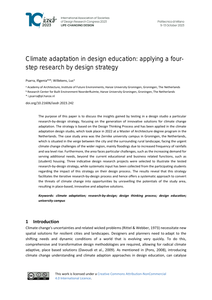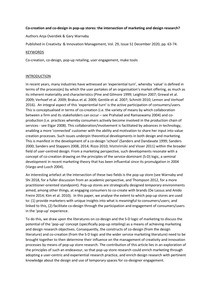Droop control is used for power management in DC grids. Based on the level of the DC grid voltage, the amount of power regulated to or from the appliance is regulated such, that power management is possible. The Universal 4 Leg is a laboratory setup for studying the functionality of a grid manager for power management. It has four independent outputs that can be regulated with pulse width modulation to control the power flow between the DC grid and for example, a rechargeable battery, solar panel or any passive load like lighting or heating.
DOCUMENT

Het lectoraat Co-Design van Hogeschool Utrecht doet met een systemisch-inclusieve ontwerpende aanpak praktijkgericht onderzoek, om complexe maatschappelijke vraagstukken te helpen oplossen. Binnen die onderzoeken stellen we vragen over het ontwerpproces en de mensen die daarbij betrokken zijn. Hoe kun je goed co-designen in de weerbarstige werkelijkheid? Wat kan helpen in die ontwerpende aanpak? Hoe kunnen mensen die niet zijn opgeleid als ontwerpers volwaardig meedoen in het ontwerpproces, en wat hebben zij daarvoor nodig aan ontwerpend vermogen? De kennis over ontwerpend vermogen die we de afgelopen vier jaar hebben opgedaan, delen we in dit boekje. We hebben dat proces getekend en beschreven als een reisverhaal van Co, die ons meeneemt op een boot over een rivier, door stroomversnellingen en langs landschappen. Met bijdragen van: Marry Bassa, Anita Cremers, Tanja Enninga, Anita van Essen, Christa van Gessel, Berit Godfroij, Joep Kuijper, Remko van der Lugt, Caroline Maessen, Lenny van Onselen, Dirk Ploos van Amstel, Karlijn van Ramshorst, Carolijn Schrijver, Fenne Verhoeven, Danielle Vossebeld, Rosa de Vries
DOCUMENT

Academic design research often fails to contribute to design practice. This dissertation explores how design research collaborations can provide knowledge that design professionals will use in practice. The research shows that design professionals are not addressed as an important audience between the many audiences of collaborative research projects. The research provides insight in the learning process by design professionals in design research collaborations and it identifies opportunities for even more learning. It shows that design professionals can learn about more than designing, but also about application domains or project organization.
DOCUMENT

In this paper we explore the influence of the physical and social environment (the design space) son the formation of shared understanding in multidisciplinary design teams. We concentrate on the creative design meeting as a microenvironment for studying processes of design communication. Our applied research context entails the design of mixed physical–digital interactive systems supporting design meetings. Informed by theories of embodiment that have recently gained interest in cognitive science, we focus on the role of interactive “traces,” representational artifacts both created and used by participants as scaffolds for creating shared understanding. Our research through design approach resulted in two prototypes that form two concrete proposals of how the environment may scaffold shared understanding in design meetings. In several user studies we observed users working with our systems in natural contexts. Our analysis reveals how an ensemble of ongoing social as well as physical interactions, scaffolded by the interactive environment, grounds the formation of shared understanding in teams. We discuss implications for designing collaborative tools and for design communication theory in general.
MULTIFILE

Author supplied from the article: ABSTRACT Increasing global competition in manufacturing technology puts pressure on lead times for product design and production engineering. By the application of effective methods for systems engineering (engineering design), the development risks can be addressed in a structured manner to minimise chances of delay and guarantee timely market introduction. Concurrent design has proven to be effective in markets for high tech systems; the product and its manufacturing means are simultaneously developed starting at the product definition. Unfortunately, not many systems engineering methodologies do support development well in the early stage of the project where proof of concept is still under investigation. The number of practically applicable tools in this stage is even worse. Industry could use a systems engineering method that combines a structured risk approach, concurrent development, and especially enables application in the early stage of product and equipment design. The belief is that Axiomatic Design can provide with a solid foundation for this need. This paper proposes a ‘Constituent Roadmap of Product Design’, based on the axiomatic design methodology. It offers easy access to a broad range of users, experienced and inexperienced. First, it has the ability to evaluate if knowledge application to a design is relevant and complete. Secondly, it offers more detail within the satisfaction interval of the independence axiom. The constituent roadmap is based on recent work that discloses an analysis on information in axiomatic design. The analysis enables better differentiation on project progression in the conceptual stage of design. The constituent roadmap integrates axiomatic design and the methods that harmonise with it. Hence, it does not jeopardise the effectiveness of the methodology. An important feature is the check matrix, a low threshold interface that unlocks the methodology to a larger audience. (Source - PDF presented at ASME IMECE (International Mechanical Engineering Congress and Exposition
DOCUMENT

The purpose of this paper is to discuss the insights gained by testing in a design studio a particular research-by-design strategy, focusing on the generation of innovative solutions for climate change adaptation. The strategy is based on the Design Thinking Process and has been applied in the climate adaptation design studio, which took place in 2022 at a Master of Architecture degree program in the Netherlands. The case study area was the Zernike university campus in Groningen, the Netherlands, which is situated in the verge between the city and the surrounding rural landscape, facing the urgent climate change challenges of the wider region, mainly floodings due to increased frequency of rainfalls and sea level rise. Furthermore, the area faces particular challenges, such as the increasing demand for serving additional needs, beyond the current educational and business related functions, such as (student) housing. Three indicative design research projects were selected to illustrate the tested research-by-design strategy, while systematic input has been collected from the participating students regarding the impact of this strategy on their design process. The results reveal that this strategy facilitates the iterative research-by-design process and hence offers a systematic approach to convert the threats of climate change into opportunities by unravelling the potentials of the study area, resulting in place-based, innovative and adaptive solutions.
DOCUMENT

This overview can be regarded as an atlas or travel guide with which the reader can follow a route along the various professorships. Chapter 2 centres on the professorships that are active in the field of Service Economy. Chapter 3 is dedicated to the professorships that are focussed on the field of Vital Region. Chapter 4 describes the professorships operating in the field of Smart Sustainable Industries. Chapter 5 deals with the professorships that are active in the field of the institution-wide themes of Design Based Education and Design Based Research. Lastly, in Chapter 6 we make an attempt to discover one or more connecting themes or procedures in the approach of the various professorships. This publication is not intended to give a definitive answer to the question as to what exactly NHL Stenden means by the concept of Design Based Research. The aim of this publication is to get an idea of everything that is happening in the NHL Stenden professorships and to pique one’s curiosity to find out more.
DOCUMENT

Abstract In this paper several meaningful audio icons of classic arcade games such as Pong, Donkey Kong, Mario World and Pac-Man are analyzed, using the PRAAT software for speech analysis and musical theory. The analysis results are used to describe how these examples of best practice sound design obtain their meaning in the player's perception. Some aspects can be related to the use of tonal hierarchy (e.g. Donkey Kong and Mario World) which is a western culture related aspect of musical meaning. Other aspects are related to universal expressions of meaning such as the theory of misattribution, prosody, vocalization and cross-modal perceptions such as brightness and the uncanny valley hypothesis. Recent studies in the field of cognitive neuroscience support the universal and meaningful potential of all these aspects. The relationship between language related prosody, vocalization and phonology, and music seems to be an especially successful design principle for universally meaningful music icons in game sound design.
DOCUMENT
Co-creation as a concept and process has been prominent in both marketing and design research over the past ten years. Referring respectively to the active collaboration of firms with their stakeholders in value creation, or to the participation of design users in the design research process, there has arguably been little common discourse between these academic disciplines. This article seeks to redress this deficiency by connecting marketing and design research together—and particularly the concepts of co-creation and co-design—to advance theory and broaden the scope of applied research into the topic. It does this by elaborating the notion of the pop-up store as temporary place of consumer/user engagement, to build common ground for theory and experimentation in terms of allowing marketers insight into what is meaningful to consumers and in terms of facilitating co-design. The article describes two case studies, which outline how this can occur and concludes by proposing principles and an agenda for future marketing/design pop-up research. This is the peer reviewed version of the following article: Overdiek A. & Warnaby G. (2020), "Co-creation and co-design in pop-up stores: the intersection of marketing and design research?", Creativity & Innovation Management, Vol. 29, Issue S1, pp. 63-74, which has been published in final form at https://doi.org/10.1111/caim.12373. This article may be used for non-commercial purposes in accordance with Wiley Terms and Conditions for Use of Self-Archived Versions. LinkedIn: https://nl.linkedin.com/in/overdiek12345
MULTIFILE

Service design is literally the design of services. Service designers improve existing services or design completely new ones. Nothing new so far. Services have been around for centuries, and every service was conceived and designed by someone. However, service design takes a different angle; a different perspective as its starting point: it is a process of creative inquiry aimed at the experiences of the individual user. ‘Service design, insights from 9 case studies’ is the final publication of the Innovation in Services programme. During this programme, creative design agencies applied the methods of service design in nine different projects.
DOCUMENT
